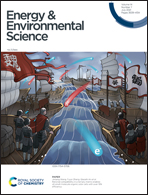A general strategy for designing two-dimensional high-efficiency layered thermoelectric materials†
Abstract
Two-dimensional (2D) thermoelectrics (TEs) with a high figure of merit (ZT > 2) are the core of the development of advanced energy technology. However, such a high ZT has rarely been realized in nanoscale thermoelectric (TE) systems, and advanced improvement theories and strategies are also absent. Here we propose a general design strategy, i.e., introducing an atom-thickness monolayer (ML) with pz-orbital occupied lone pairs into the van der Waals (vdW) gap of layered materials to enhance the ZT. As an example, a new class of 2D room-temperature TE materials, BiBi2X3 (X = S/Se/Te), are successfully predicted, which are obtained through inserting Bi ML into the vdW gap of a Bi2X3 bilayer (BL). The inserted Bi ML, on one hand, brings high electronic density of states [g(E)] and sharp increase in g(E) near the Fermi level and therefore produces a large power factor. On the other hand, it achieves individually suppressed low-frequency and high-frequency related phonon transport through introducing local collective vibration modes and sensitive electrostatic interaction. As a result, 2D BiBi2X3 exhibits an ultrahigh ZT (2.12 for 2D BiBi2Te2S around room-temperature). The design strategy and the ultrahigh 2D ZT are of vital importance for advanced TE technology.



 Please wait while we load your content...
Please wait while we load your content...